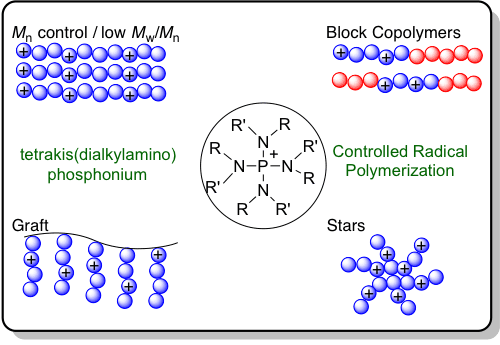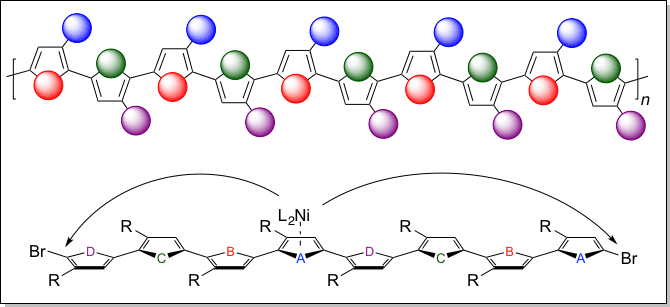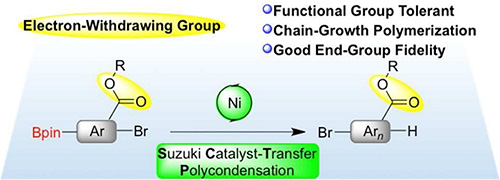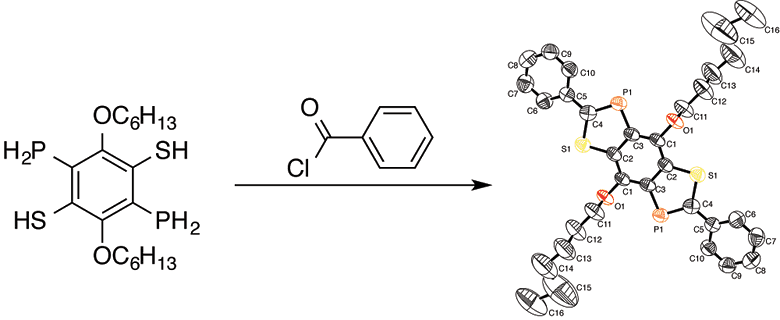Projects
Phosphonium Polymers For Anion-Exchange Membranes

Polyelectrolytes are an important class of materials that derive their unique chemical and physical properties from electrostatic interactions between ion pairs along the polymer chain. Cationic polyelectrolytes, in particular, are being extensively investigated for a variety of applications including Anion Exchange Membranes (AEMs). AEMs have shown promise as an alternative to Proton Exchange Membranes (PEMs) for fuel cell applications however, the long term stability of organic cations under alkaline conditions at higher temperatures (80° C) remains challenging. Tetrakis(dialkylamino)phosphonium, [P(NR2)4]+ cations have been shown to be highly stable in alkaline media but the number of polymeric materials bearing this cation remain limited. Our efforts have focused on synthesizing [P(NR2)4]+ based monomers and utilizing controlled/living polymerization methods, i.e. RAFT, to develop stable, well-defined polyelectrolyte architectures with tunable ion content.
Exploring Sequence in Group 16 Copolymers

Precise monomer insertion along a polymer backbone can afford biological macromolecules with a wide range of structural and functional properties. This continues to inspire researchers to synthesize macromolecules with controlled sequences as a means to manipulate structure and function. Sequence control may be especially effective in tuning the electronic structure of conjugated polymers because of the delocalized pi-electrons along the backbone. Conjugated polymers are typically synthesized in a step-growth fashion using metal catalyzed cross-coupling techniques but, chain-growth methods are possible using catalyst-transfer polycondensation (CTP). In our laboratory, we are exploring how sequence impacts the electronic properties and organization of group 16 periodic copolymers as compared to the random systems.
Suzuki Catalyst-Transfer Polycondensation using Nickel Catalysts

Controlled synthesis of conjugated polymers with functional side chains is of great importance, affording well-defined optoelectronic materials possessing enhanced stability and tunability as compared to their alkyl-substituted counterparts. However, the highly reactive monomers typically employed in catalyst-transfer polycondensation (e.g., organomagnesium or organozinc reagents) often limit the selection of solubilizing substituents tethered to the aromatic ring. We are currently exploring nickel catalysts for Suzuki polycondensation due to the lower cost as compared to palladium and the facile oxidative addition observed with a diverse range of pseudohalides or nonactivated halides. Development of this protocol should lead to enhanced substrate scope for the controlled synthesis of conjugated polymer materials with the eventual goal of electron-deficient polymers and donor-acceptor copolymers.
Stille-based Catalyst Transfer Polycondensation

In the last decade, significant progress has been made in the controlled synthesis of semiconducting polymers. Metal-mediated catalyst-transfer polycondensation (CTP) has emerged as a tool to enable precise synthesis of conjugated architectures. CTP methods have been developed using Kumada (organomagnesium), Suzuki–Miyaura (organoboron) and Negishi (organozinc) cross-coupling protocols. However, comprehensive understanding of the polymerization mechanism and alternative controlled synthesis methods will help expand substrate scope for this important methodology and enable the preparation of more complex conjugated architectures. In our group, we have begun exploring Stille cross-coupling using a carbene-supported palladium catalyst. This method should open the door to precise synthesis of n-type semiconducting polymers and donor-acceptor low band gap alternating copolymers.
Incorporating Phosphorus Into Organic Materials:
How Heteroaromatic Rings Affect π-Conjugation

There is a great deal of research today focusing on the synthesis and design of conducting polymers for lightweight electronic devices. The molecular design of conjugated materials today has been remarkable as researchers continue to employ strategies to tune these macromolecules for device applications. One method to modulate electronic materials is the incorporation of main group elements or transition metals into conjugated polymer systems. The incorporation of nitrogen and sulfur is most common but there is also considerable interest in developing phosphorus containing conjugated materials as these show very different behavior when compared to their nitrogen analogues. The incorporation of heteroaromatic systems bearing phosphorus atoms is currently under investigation in the Noonan group.